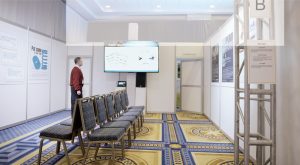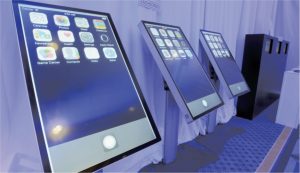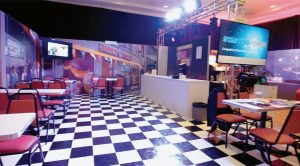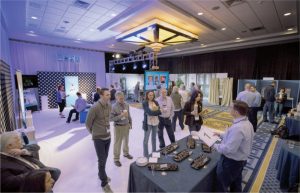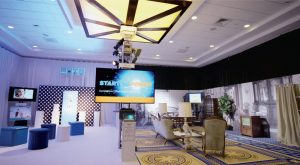Engaging Professionals with Transformative Learning
Cover Story – by Pam Marinko
Engaging tenured sales professionals can be a big challenge.
There’s nothing like the feeling after a training rollout when you’ve done some fantastic work. Your people are delighted to get back to the field to test those new ideas, and the objectives you set out to achieve are realized. That touchdown feeling always keeps us coming back for more!
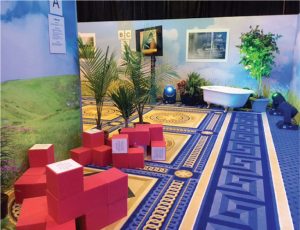 Paul LoVerde, director of oncology training, and Anne Demetrio, associate director, marketing, both of Novartis Oncology, felt this firsthand with a recent new product launch meeting. As the Novartis leads on this project, LoVerde and Demetrio were in charge of building a training experience for their sales specialists that would get the team excited about both the new product and the launch itself. This is the story of how they successfully executed a one-of-a-kind rollout.
Paul LoVerde, director of oncology training, and Anne Demetrio, associate director, marketing, both of Novartis Oncology, felt this firsthand with a recent new product launch meeting. As the Novartis leads on this project, LoVerde and Demetrio were in charge of building a training experience for their sales specialists that would get the team excited about both the new product and the launch itself. This is the story of how they successfully executed a one-of-a-kind rollout.
Engaging tenured sales professionals can be a big challenge, so Novartis actively sought fresh ideas and innovative partners, and emphasized collaboration to keep sales specialists at the top of their game. In early 2017, Novartis was launching a
new product that had a similar profile to a competitive product, already on the market. As a second-to-market entrant, they were tasked with staying motivated to win, as well as preparing 160 oncology sales specialists and managers to establish the new product as an appropriate alternative for specific patient types and to grow market share. They wanted the sales team to leverage competitive differentiation strategies to accelerate product adoption, understand how to affect change by identifying and satisfying unmet patient and customer needs and stay motivated as a second-to-market entrant.
Novartis partnered with Proficient Learning, which worked with them to incubate and evolve an exciting transformative learning solution. This approach evolved into a series of workshops consisting of four unique experiential learning environments, or Experience Rooms, to provide sales specialists with a way to think differently and self-discover solutions to a known challenge with a new product launch. As with any workshop, the idea for this transformative learning experience took plenty of ideation and planning, and of course dedicated teamwork to make it all come together.
How Our Idea Evolved
The first step was the concept and design phase – a collaborative, iterative process among the Novartis product brand team led by Demetrio, the training team led by LoVerde, and the Proficient Learning design and delivery team. They began with an information gathering and brainstorming session to identify the target outcomes from the training and the potential constraints. From there, the development team created a series of high-level concept options that best supported our brand launch strategy. Novartis customer teams reviewed these options and provided feedback, which ultimately led to a final creative concept of competitive differentiation using non-pharma examples or cases in each Experience Room.
“In the beginning, we weren’t exactly sure of which direction we wanted to take this training endeavor. We knew we wanted something a little flashy that was both impactful from a sales perspective and memorable enough for the sales specialists that they’d be enthusiastic about the new product. The early brainstorming and concept sessions helped us funnel our ideas and come up with fun ways to achieve our training goals,” Demetrio said.
With the creative concept in place, the design and development team now had to fully immerse themselves in the environments and nuances of each chosen brand or company that would represent the Experience Rooms. There were eight in total, as each of the four rooms compared two brands. The team researched the brands, conducted in-depth interviews with employees, customers and marketing teams, and took various field trips to ensure they were knowledgeable enough to proceed. Then they created a series of immersive learning experiences related to each of the selected non-pharma cases.
The project management team worked in tandem with graphic designers, multimedia specialists, fabricators, printers, meeting planners and hotel staff to determine how to execute the concepts in the training environment, which in this case was a hotel meeting room. They were presented with 3D images of the rooms so they could better visualize the final solution understand how the training rooms so they could better visualize the final solution, understand how the training achieved target outcomes and communicate any foreseeable challenges to the design team. As the design and review process continued, Novartis and Proficient Learning participated in a series of live and virtual meetings and video conferences, and used interactive online tools to refine the concepts.
As often is the case, there were some logistical challenges to tackle. Being highly interactive, the Experience Rooms required extensive coordination with the meeting planner team to ensure support materials and staging elements would work in the physical space allocated to the training. The instructional design lead, project manager and on-site hotel manager conducted a physical site visit once the space was confirmed. During the site visit, the team also developed setup, teardown, and participant flow space and timing plans.
LoVerde said, “The closer we got to the finished training plan, the more excited we were to see how it would come to fruition. A lot of long days and extensive planning ultimately paid off though because the rooms were a real hit with the sales specialists!”
The Resulting Experience Rooms
Once they overcame the challenges and completed planning and execution, the result was a workshop featuring four Experience Rooms, staffed by eight facilitators. Through each rotation of the four rooms, sales specialists were immersed in an environment with a distinct theme and business case highlighting companies or brands that have become successful as second-to-market entrants. Each room introduced participants to the strategy, market positioning, branding, product differentiation and winning execution of that particular brand. Following each immersive adventure, participants applied and integrated the key concepts with their pre-launch strategy.
“This workshop was unlike any other we’ve had. The way that the rooms showcased successful brands with strong second-to-market strategies was hopeful, inspiring and empowering for the participants. They could fully relate to it all,” LoVerde added.
Each Experience Room was a large-scale production that brought to life two competing companies or brands, one of which was a second-to-market entrant. They showed how the second-to-market entrants initially established themselves and how they grew to become the dominant product in the market.
Participants were exposed to a variety of media such as live, immersive interactions and contextual video elements. Some rooms featured company interviews and product displays while others exhibited photo montages and shared product samples. This variation in sensory elements had the intended engagement effect, so much so that in each room the event was punctuated when facilitators were forced to intervene in ongoing discussions once it was time to rotate to the next Experience Room.
Within each room there were five or six Experience Stations that presented
participants with real-world examples of how these companies overcame market
barriers by establishing new customer experience criteria, personalizing the customer experience, or repositioning the product to meet unknown or unrecognized needs. All stations demonstrated a component of the company brand or strategy that could be applied to this company’s product launch.
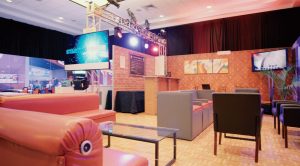 The Experience Rooms each followed a similar progression showcasing familiar print elements depicting the brand and positioning, audio and video elements that brought the positioning to life, and live interaction that allowed participants to evolve their thoughts regarding strategy and apply it to their own product, markets and customers. Room facilitators noted that initially participants had many questions, but these evolved into aha moments as the self-discovery process progressed.
The Experience Rooms each followed a similar progression showcasing familiar print elements depicting the brand and positioning, audio and video elements that brought the positioning to life, and live interaction that allowed participants to evolve their thoughts regarding strategy and apply it to their own product, markets and customers. Room facilitators noted that initially participants had many questions, but these evolved into aha moments as the self-discovery process progressed.
Part of the Experience Station design included natural discussion areas and a variety of seating options, strategically arranged to encourage full participation. Participants discussed and recorded how to apply the strategies to their own selling environments, enabling them to personalize the workshop to their own selling needs and territory priorities. Workshop photos depicted all participant groups in each room and there was no visible drop-off in engagement or participation from the first rotation to the fourth.
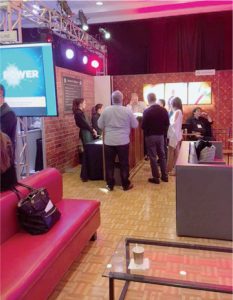 Demetrio said, “Between the immersive learning environment, the diverse sensory experiences from one room to the next and the familiar brands selected to tell each story, participants had no problem relating to what was being demonstrated, interpreting and absorbing the information, or forming their own opinions and game plans based on what they learned ”
Demetrio said, “Between the immersive learning environment, the diverse sensory experiences from one room to the next and the familiar brands selected to tell each story, participants had no problem relating to what was being demonstrated, interpreting and absorbing the information, or forming their own opinions and game plans based on what they learned ”
This all goes to show that it pays to invest in a creative strategy when coming up with a new sales training initiative. When you put a lot of work into the learning method itself, your sales specialists will have a reason to be passionate about what they’re selling, stay engaged with the product and get inspired to explore alternative sales strategies.
Pam Marinko is chief executive officer of Proficient Learning. Email Pam at pam.marinko@proficientlearning.com.

